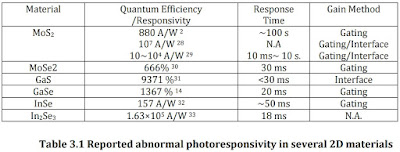"...the low absorption issue is more challenging in 2D materials, because the atomic thickness in 2D materials results in an intrinsically low absorption rate usually less than 10%. In typical single layered graphene, the absorption rate is about 2.3%.
As mentioned in the previous chapters, the low absorption rate is an issue must be face when fabricating an optoelectronic device. The issue should be more significant in atomically thin materials. However, one can easily found it is not always the case when reviewing recent publications in 2D photodetectors. It is very sarcastic that it is very common that 2D photodetector can have external quantum efficiency much higher than 100%, and it is more awkward that the society more or less accepts this strange phenomenon without careful consideration and even competes for even higher quantum efficiency. Table 3.1 listed some most cited reports stating very high quantum efficiency."
"But this does not means the 2D based photodetector is much more supreme than traditional silicon based photodetector. Actually, it can be found that most reported 2D photodetectors have very long response times, making the 2D photodetector nearly useless in actual application.
Pursuing higher responsivity is not blamable, but photoresponsivity is not the only key parameter that determines the performance of a photodetector and other optoelectronics. Other parameters such as response time, signal-to-noise ratio (S/N) are also as important, especially when facing the applications in optoelectronic communication, signal processing, etc. Consequently, the competition on photoresponsivity by compromising other indexes is unreasonable.
Even worse, few publications ever discussed the origin of such high quantum efficiencies in 2D photodetectors, leaving so much unpredictable, unrepeatable and irresponsible results and misleading the field."
